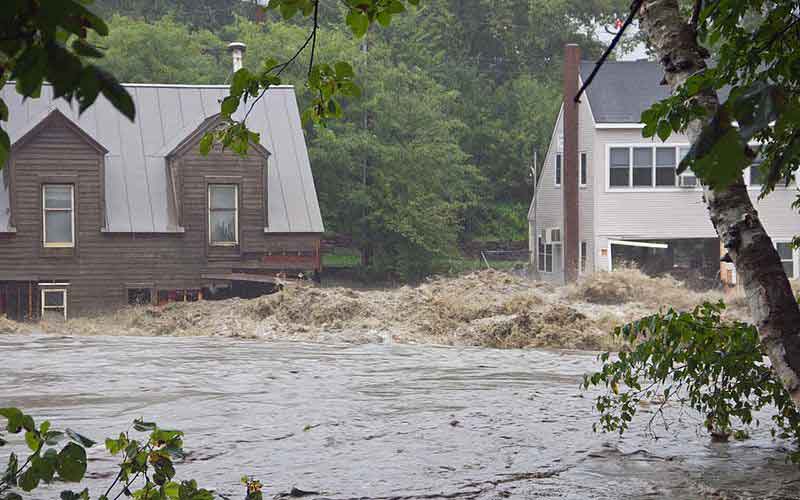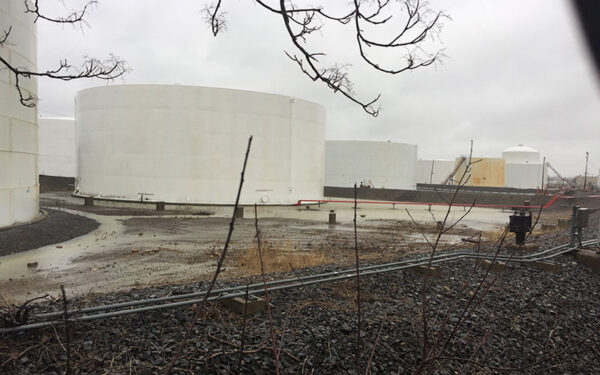
Federal flood protections are a necessary and critical step in protecting communities from climate impacts. Now we need to follow that lead through state and local action. Photo: Stephen Flanders
Barely a week before Hurricane Harvey put much of Houston under water – forcing 16 Texas hospitals to close – then-President Trump revoked an order requiring federally funded infrastructure be designed to withstand climate-induced risks like extreme flooding and sea level rise. The revoked order, the 2015 Federal Flood Risk Management Standard, applied to roads and bridges, public housing, water treatment facilities, and hospitals, among other infrastructure.
While that 2015 standard would not have changed the outcome in Houston that summer, it lay the groundwork for protecting communities against future Harveys and represented a significant step forward on climate resilience at the federal level. Trump’s reversal, which cited the need to build infrastructure “quickly and inexpensively,” was both shortsighted and denied the destructive reality of the climate impacts we are already seeing.
That’s why advocates cheered last week when President Biden reinstated the Obama-era flood protection standard among his first acts in office. The Biden administration is sending a clear signal that building according to climate patterns of the past is no longer acceptable – we must acknowledge and address increasingly frequent and extreme flooding caused by climate change.
Now we need state and local leaders to acknowledge and address these risks, too. Reinstating the federal standard is a critical first step for increasing our national infrastructure’s climate resilience – one that signals the urgent need for action here at home.
State and Local Standards Fail to Account for Climate Change Risks
The Flood Risk Management Standard covers a huge swath of critical, federally funded projects like roads and bridges, public housing, hospitals, and more. However, it does not apply to private development or state and local infrastructure projects that do not receive federal dollars.
The lack of state and local standards to address climate risks creates huge gaps in our regulatory structure that jeopardize the health and safety of New Englanders and our economy. To address these risks, we need individual cities and states to follow the federal lead and pass stringent flood management standards for all development and infrastructure.
How New England States Can Follow Biden’s Lead
Every New England state can and should take steps now to follow the lead of the federal administration on climate resilience:
Revise State Building Codes: Every New England state must assess its building codes and revise them to address climate change impacts like extreme temperatures and precipitation, more intense storms, and sea level rise.
Current codes are based on historical averages of climate patterns of the past, not the future. Buildings constructed today will be around for at least the next 50 years. Yet our climate will be vastly different in 2070, and failing to account for those changes today threatens New Englander’s future health and safety. It also drives up taxpayer costs associated with rebuilding after a storm.
Most importantly, in states like Massachusetts, where cities and towns are bound by the State building code, revisions must provide flexibility to extend flood-resistant construction standards to the future floodplain, based on forward-looking climate projections, not historical patterns.
Develop Climate-Resilient Zoning: Cities and towns are charged with regulating the use of land through zoning and other regulations to protect public health, safety, and welfare. Protecting residents from climate risks certainly fits this bill.
Cities and towns can use their authority to pass zoning that reflects increasing risks. For example, they could prohibit new development in the highest-risk areas, require new development to be elevated above future flood levels, or mandate that critical mechanical equipment be located on the top floors or roof of new structures.
Local zoning also presents an opportunity to plan for climate risks at a neighborhood-wide or district-wide level to ensure that the approach to climate resilience is consistent, not ad hoc.
Mandate Climate Risk for Utilities: Investor-owned utilities, including gas and electric companies, must be held accountable for planning for climate risks.
Currently, no comprehensive standards exist to mandate how these companies identify and plan for threats to their infrastructure and operations from climate change. We have seen the fallout from the lack of preparation in past storms: exploding substations, widespread power outages, and worse.
Following Hurricane Sandy, New York’s Con Edison was forced to undertake a climate vulnerability study. We in New England shouldn’t wait for a disaster before assessing our own vulnerabilities. Local utility commissions can and should require more long-term planning and investment strategies that account for climate change risks.
Pass Flood Disclosure Laws: Most homebuyers don’t know a property’s flood history – let alone the future flood risks to a property due to climate change. Few states require sellers to disclose this information (like you would be required to for things like lead paint or asbestos). A recent study by the Natural Resources Defense Council revealed that Connecticut and Rhode Island are the only New England states with flood disclosure laws – and both were graded at a D.
In contrast, Oklahoma, Mississippi, and Louisiana have some of the country’s best flood disclosure laws. Their laws require sellers to disclose whether a property lies within the flood zone, as well as its past flood history and whether flood insurance is required. New England states have an opportunity to lead the nation by taking these requirements a step further: requiring disclosure based on future flood risk for the life of a standard 30-year mortgage.
New Era of Climate Regulation
With the Biden administration, we are optimistic that the U.S. can once again begin comprehensively addressing the climate crisis. Emissions reductions remain a critical task in this fight, but we at CLF know we also must protect people and property from the climate impacts we can no longer avoid. That starts with creating requirements for climate-resilient development and infrastructure here at home. While federal action can help set the tone for this new era of climate regulation, state and local governments can and should continue to lead the way.



